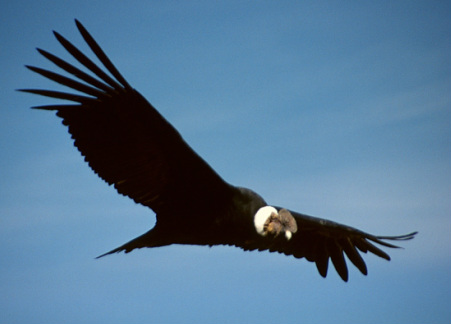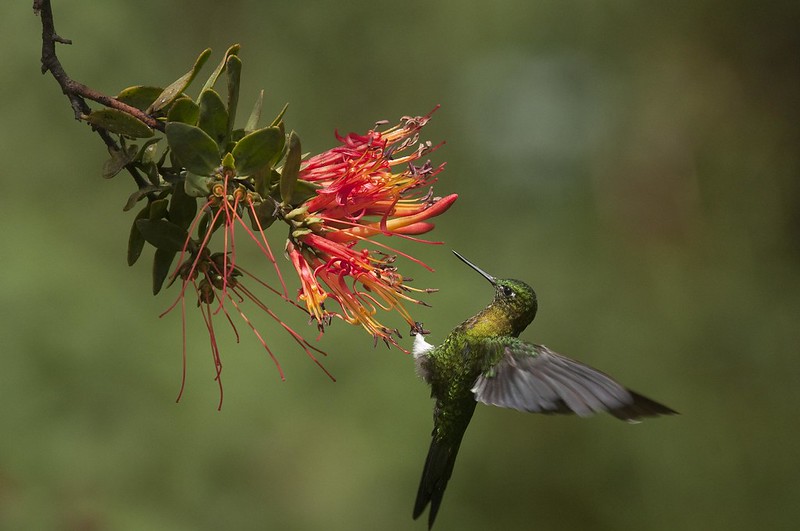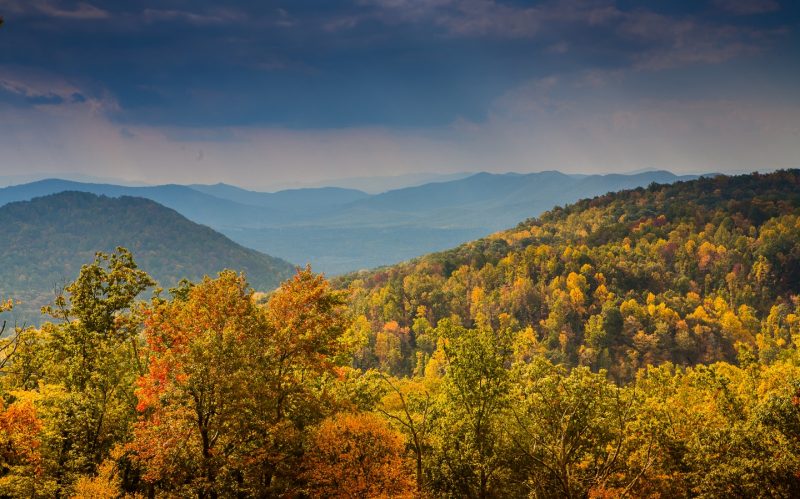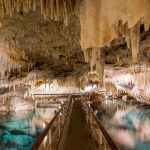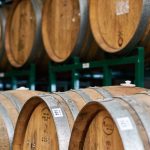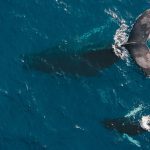Into the great wide open
Ian Stalker
It’s great being in the Great Outdoors.
And there’s no shortage of ways for people to get up close and personal with nature, leaving city settings behind in locales that may no be far from urban areas.
Travel Courier is sharing some options for those seeking some fresh air:
Krista Leddy
Métis Crossing
Métis Crossing clients may paddle pass reminders of the past.
Smoky Lake, Alta.’s Métis Crossing — described as “Alberta’s first major Métis cultural interpretive destination” and found a little over an hour northeast of Edmonton — includes among its programs Paddle into the Past, which enables spring and summer visitors to paddle on excursions of around four hours on the North Saskatchewan River in 22-foot-long canoes that hold eight people and recall the massive canoes the voyageurs — who were frequently Métis — used as they paddled and portaged across much of what is now Canada centuries ago as part of the fur trade.

Krista Leddy, Métis Crossing’s experience development coordinator, says Paddle into the Past gives participants insights into the voyageur lifestyle while sparing them the hardships that the voyageurs — often French-speaking explorers who married Indigenous women or descendants of such couples — faced on their long journeys between the West and Eastern cities.
“Through this immersive experience, you will learn the importance of canoeing and portaging to the Métis Community in just a short amount of time,” Leddy says. “Because the canoes are very lightweight and stable, they are very easy to paddle. It is also important to keep in mind that you are floating on the river – which helps out a lot. The trips are guided with a certified guide on each canoe.”
Leddy says the large canoes provide a different paddling experience than what people are generally used to, with regular canoes having a smaller turning radius, while the larger ones take a “little more teamwork to steer. With that being said, a larger canoe is very hard to tip over, making for a smoother ride.”
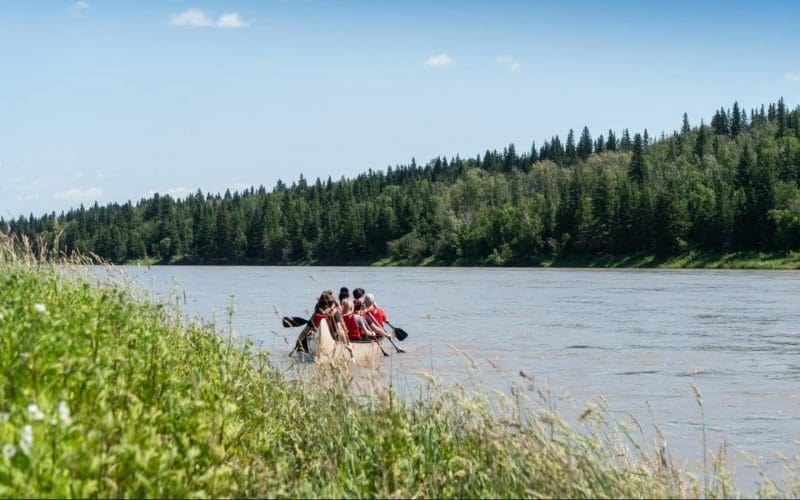
Those who sign up for Paddle into the Past will find themselves retracing part of a historic fur trading route home to a Hudson Bay Company trading post.
Leddy says the voyageurs were hugely important to the history of this country “as they created communities that opened up the West and were able to help map out the area for trading.
“They created lives that thrived from living from the land and we are very proud of the understanding that they had to believe that everything is connected to the land and that we are all connected as people. It is also important to note that not all Métis families originate from voyageurs, but many of the families had roles that supported the skills of the traders.”
She says the Métis have a distinct Indigenous story to tell.
“We believe there are significant opportunities to educate and share our culture with the public. This is a true opportunity at Métis Crossing — we’re excited about sharing our culture and history through unique programming – whether it be for groups, individuals, schools, or corporate teams.”
Mike Welling
Appalachian Offroad Adventure
Mike Welling is inviting people to at times travel a really rocky road.
Or perhaps rocky trail would be a more fitting description.
Welling and his wife run Appalachian Offroad Adventure, which has backcountry tours in Virginia’s Shenandoah Valley that use the rugged vehicles whose manufacturer once liked to boast that it “wrote the book on 4-wheel-drive.”
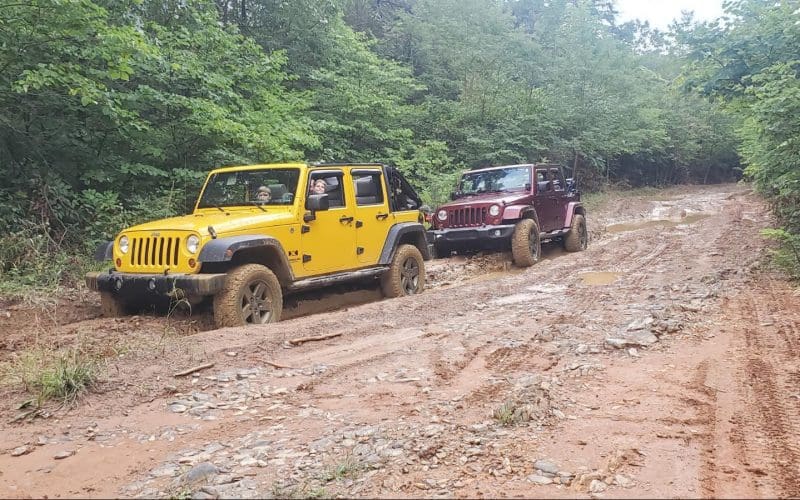
The 2.5- and 5-hour guided Jeep tours — which take place near the community of Winchester — have participants follow Welling and his wife in their lead vehicle, with the mini-convoys setting out after clients receive instructions on the likes of “how to approach obstacles,” the importance of which was underscored by video showing an Appalacian Offroad Adventure Jeep slowly angling around and over sizeable rocks. Indeed, Welling says his tours bring the offroading “experience to people who don’t have a Jeep or don’t want to destroy their Jeep.”
The specially designed Jeep Wranglers have 40 miles of trails of varying difficulty that are found between 1,000 and 3,000 feet above sea level to choose from, with Appalachian Offroad Adventure noting chosen routes may have “rocks, ruts, creek crossings, steep hills, gulleys and mud pits.” Clients at times may find themselves on “some of the most extreme terrain on the East Coast” of the United States.
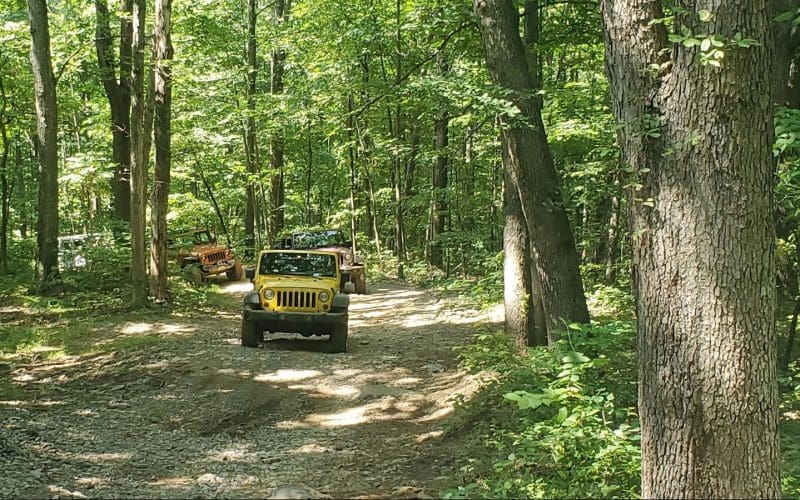
Those who sign up for the tours may also encounter “rocks bigger than the Jeep” itself, Welling adds.
Jeeps used can comfortably seat four people, who can take turns driving.
Those signing up for the tours can go swimming during them and may spot wildlife.
And Welling says navigating rough terrain in an Appalachian Offroad Adventure Jeep needn’t be seen as a daunting experience by those wondering if they should book a tour.
“The key is to come out and have a good time,” he says.

Laura Nesteneau
Quito Tourism Board
Laura Nesteneau says those visiting Quito and the surrounding area will have no trouble spotting some of our feathered friends.
Nesteneau promotes Quito in this country and says birdwatching opportunities in and around the city reflect the birdwatching opportunities found in Ecuador in general.
“Quito is one of the most diverse cities on the planet in terms of birds,” she says. “Ecuador has the highest density of bird species in the world, with more than 1,670. In Quito you will find birds of all shapes and colours and that magic depends on where you are: there are high mountain habitats, dry Andean forests, humid forests, rivers, ravines, grasslands, waterfalls, and everything within a few kilometres of distance.”
One of the unique species is the Andean Cock of the Rock, which is known for its unique courtship dance, Nesteneau reports. Ornithologists can also visit the Paz de las Aves Refuge, home to hummingbirds of all colours, toucans, parrots and quetzals. There are also birdwatching tours in the northwest, where people can admire the imposing Andean condor.
“The Andean condor is an emblematic animal of Ecuador (it’s found in Ecuador’s National Emblem) and especially in the Ecuadorian Andes,” Nesteneau says. “This impressive bird is the largest flying animal on the planet, whose outstretched wings are approximately 3 meters long and have a total weight of up to 12 kilos. You can find it gliding in the blue sky of our city, although they are known to be shy and hard to find birds.
“The Andean condor, the king of our skies, has a life of up to 75 years, making it one of the longest-lived birds, whose majesty decorates mountains and cliffs around Quito, amidst a beautiful and abundant flora and fauna,” Nesteneau continues.
She says Quito has built a following among birders.
“Birdwatching has turned Quito into one of the most important bird destinations in the world,” Nesteneau adds. “However, we need to expand this awareness not only to bird enthusiasts, but also to families and kids that can discover the amazing nature and have an incredible travel experience. If you have half-a-day, a day, five days, a week or a month, Quito has enough to fill your eyes with the most eye-popping birds.
“There are many local travel agencies specializing in tailor-made birding and photography tour packages that also have a strong conservation ethic. So when you sign up for a tour you can rest assured that you will be receiving the highest quality birding tour and will also be helping conserve some amazing habitat for many wonderful birds and other cloud forest creatures, and also will be helping promote responsible ecotourism in one of the world´s most biodiverse regions.”

Taylor Spellman
Virginia's Blue Ridge
Virginia’s Blue Ridge is ready to turn a new leaf in a major way.
Virginia’s Blue Ridge spokeswoman Taylor Spellman says local landscapes will be putting on a particularly dazzling show courtesy of Mother Nature.
“The beauty of fall in Virginia’s Blue Ridge is second to none,” Spellman says. “The stunning landscape of the Blue Ridge Mountains, including the Appalachian Trail, makes the Roanoke Valley in Virginia’s Blue Ridge one of the best places in the world to see fall colour. Though it varies every year, peak fall colour typically occurs mid-to-late October.
“Roanoke in Virginia’s Blue Ridge is the largest destination located on Virginia’s Blue Ridge Parkway. Our metro mountain destination offers some of the best fall colour views paired with amenities of a big city, without the crowds. Directly off of Interstate 81, the Roanoke Valley boasts a robust craft culinary cuisine and beverage scene paired with a wide selection of lodging and activities and over 1,000 miles of trails, all within an hour drive.
“Roanoke and Virginia’s Blue Ridge is in between the Shenandoah Valley and Asheville, allowing for visitors to plan a spectacular Virginia/North Carolina fall road trip.”
Spellman says it’s impossible to miss the “fall colour consuming the mountains the region is surrounded by” when exploring the area by car. “Each scenic drive leads to a vibrant, fall-filled community where visitors can opt for an aerial view of the treetops or admire the colour up close while paddling, biking, or hiking beneath golden, maroon and orange canopies of the Blue Ridge Mountains. Camping is also a great way to soak up the season in Virginia’s Blue Ridge.
“Explore Park, Carvins Cove, Mill Mountain, Peaks of Otter, Waid Park, Upper James River Water Trail are popular spots in Virginia’s Blue Ridge to spend the day soaking in color,” Spellman adds.

